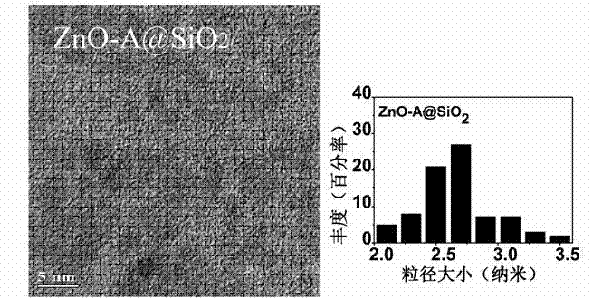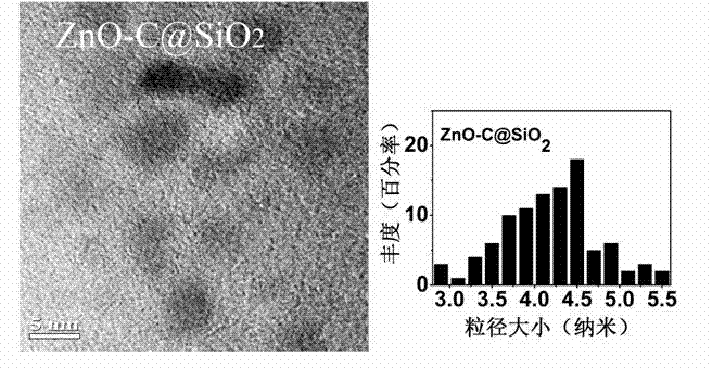Core-shell zinc oxide-silica nanoparticle, and preparation method and application thereof
A technology of zinc oxide nanoparticles and nanoparticles, which is applied in the field of nanomaterials, can solve the problems of large particle size, unsatisfactory products, and application limitations of bioluminescence labeling, etc., and achieve the effect of mild reaction conditions
- Summary
- Abstract
- Description
- Claims
- Application Information
AI Technical Summary
Problems solved by technology
Method used
Image
Examples
Embodiment 1
[0027] (1) Preparation of ethanol solution of zinc oxide nanoparticles
[0028] Dissolve 2.35 g of zinc methacrylate in 100 ml of absolute ethanol, stir and heat to 80 o C, reflux for 1 hour; dissolve 1.26 g of lithium hydroxide monohydrate in 100 ml of absolute ethanol, and use ultrasound to help dissolve. Then the ethanol solution of zinc methacrylate and the ethanol solution of lithium hydroxide were mixed, stirred at room temperature and reacted for 24 hours, then 40 o C was concentrated by rotary evaporation, added ethyl acetate to precipitate, centrifuged at 5000 rpm for 5 minutes, discarded the supernatant, and dissolved the precipitate with 200 ml of absolute ethanol (precipitation mass 0.32-0.4 g). The resulting ethanol solution was designated as ZnO-A.
[0029] (2) Preparation of ethanol solution of zinc oxide nanoparticles coated with organic silicon monolayer
[0030] Take 50 ml of ZnO-A solution (zinc oxide nanoparticles 0.08-0.1 g) and add 50 ml of absolute et...
Embodiment 2
[0038] The preparation method is the same as in Example 1, but the lithium hydroxide monohydrate used in the step (1) is 0.63g, and the hydrolysis rate of the zinc salt slows down under this condition, and finally the ZnO average diameter obtained is 3.8 nanometers (attached figure 2 ), its aqueous solution is denoted as ZnO-BSiO 2 . Its luminous wavelength is around 513 nanometers, and its quantum efficiency is about 48%. It can emit stably in both phosphate buffer and RPMI 1640 medium.
[0039] The cell culture and test process were the same as in Example 1. The semi-lethal concentration of human cervical cancer cell Hela is about 0.3mg / mL, and the ZnO quantum dots can enter the cytoplasm, but it is not obvious in the nucleus. The experimental results show that the ZnO nanoparticle quantum dots in the present invention have good Cell compatibility, and in cells, it can stably emit light under continuous ultraviolet excitation.
Embodiment 3
[0041] The preparation method is the same as that in Example 1, but the lithium hydroxide monohydrate used in step (1) is 0.63 g, and the stirring time at room temperature after mixing zinc methacrylate and lithium hydroxide ethanol solution in step (1) is 20 days. Under this condition, the average diameter of ZnO finally obtained is 4.6 nm (attached image 3 ), and its aqueous solution is denoted as ZnO-CSiO 2 . Its luminous wavelength is around 550 nm, and its quantum efficiency is about 33%. It can emit stably in both phosphate buffer and RPMI 1640 medium.
[0042] The cell culture and test process were the same as in Example 1. The semi-lethal concentration for human cervical cancer cell Hela was about 0.2 mg / mL. The ZnO quantum dots could all enter the cytoplasm, but it was not obvious in the nucleus. The experimental results showed that this The ZnO nanoparticle quantum dots in the invention have good cell compatibility, and can stably emit light under continuous ultra...
PUM
| Property | Measurement | Unit |
|---|---|---|
| Lc50 | aaaaa | aaaaa |
| The average diameter | aaaaa | aaaaa |
| Luminous wavelength | aaaaa | aaaaa |
Abstract
Description
Claims
Application Information
 Login to View More
Login to View More - R&D
- Intellectual Property
- Life Sciences
- Materials
- Tech Scout
- Unparalleled Data Quality
- Higher Quality Content
- 60% Fewer Hallucinations
Browse by: Latest US Patents, China's latest patents, Technical Efficacy Thesaurus, Application Domain, Technology Topic, Popular Technical Reports.
© 2025 PatSnap. All rights reserved.Legal|Privacy policy|Modern Slavery Act Transparency Statement|Sitemap|About US| Contact US: help@patsnap.com



